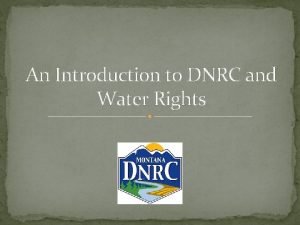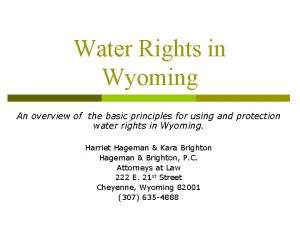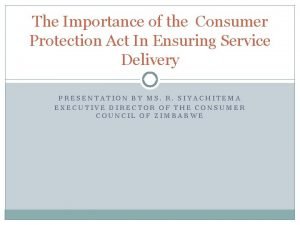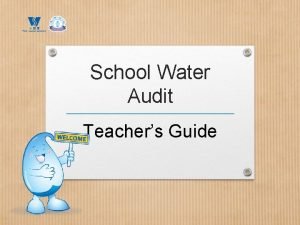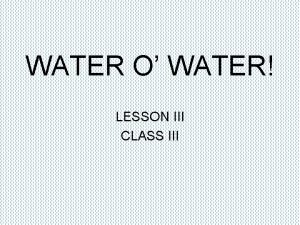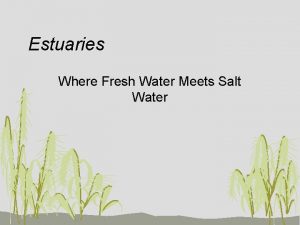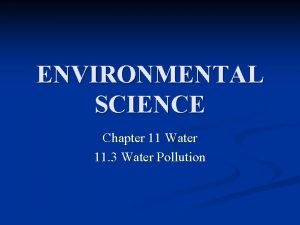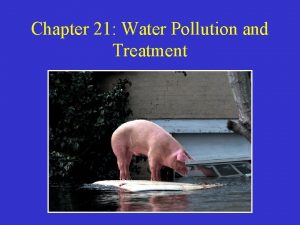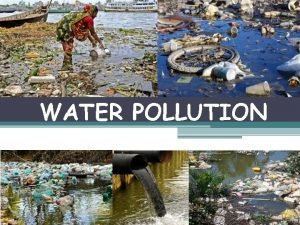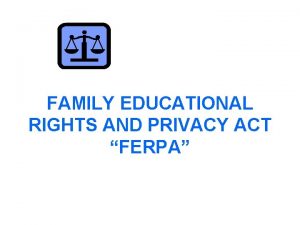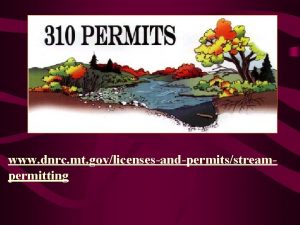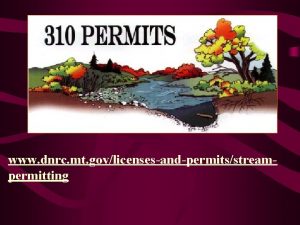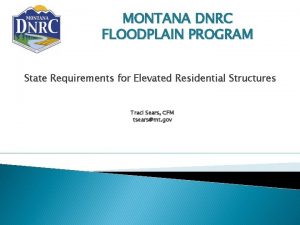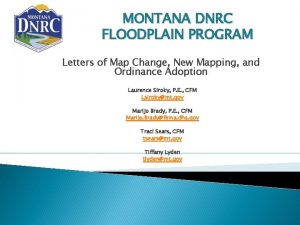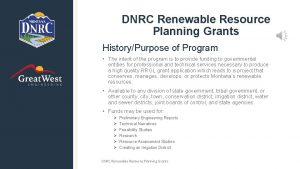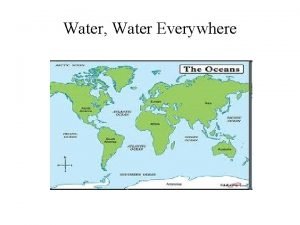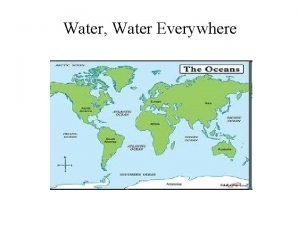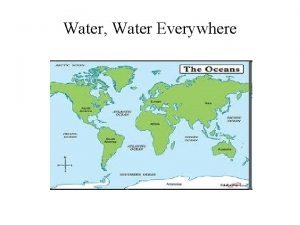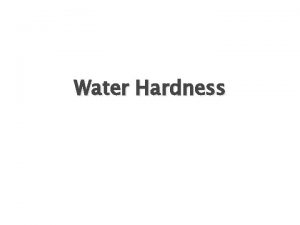An Introduction to DNRC and Water Rights DNRC









































- Slides: 41

An Introduction to DNRC and Water Rights

DNRC – The Big Picture The DNRC is a Montana State Government Department under the Executive Branch, with the Director appointed by the Governor DNRC consists of 5 divisions, Trust Land Management, Conservation and Resources Development, Forestry, Water Resources, and Oil and Gas Conservation.

DNRC Mission Statement To help ensure Montana’s land water resources which will provide benefits for present and future generations.

DNRC WRD Mission Statement The Water Resources Division promotes and coordinates the beneficial use, conservation, protection, and development of Montana’s water resources. Toston Hydropower Dam, pictured at right, is a DNRC-owned project.

DNRC WRD Organization Structure Bureaus Water Rights Bureau Adjudication Bureau Water Projects Bureau Water Management Bureau Water Operations Bureau

Regional Offices

Three Take Home Points 1. All water uses should have a paper water right (only a few exceptions). 2. Water rights need maintenance, just like any other property right. 3. Correct ownership and addresses are important!

Basic Principles of MT Water Law …any use of water is a public use and that the waters within the state are the property of the state for the use of its people and are subject to appropriation for beneficial uses…(§ 85 -2 -101, MCA) [a] “water right” means the right to use water…(§ 85 -2 -422, MCA) “Appropriate” means: to divert, impound, or withdraw…(§ 85 -2 -102, MCA)

Basic Principles of MT Water Law Doctrine of Prior Appropriation First in time, first in right Makes the priority date, or date of first use of the water, key to water law Also called “Western Water Law” – originated in Western States to accommodate irrigation and mining needs of the developing west As opposed to the Riparian Doctrine, or “Eastern Water Law” – where stream access is the key to the right to use water

Basic Principles of MT Water Law • Limited to beneficial use (no waste) – Beneficial use is the basis, measure and limit of the water right. • Based on capacity of water delivery system, amount of water actually put to beneficial use, amount of water necessary for the use (duty of water), and period of use based on actual need for water. – Includes agricultural, stock water, domestic, fish & wildlife, industrial, irrigation, mining, municipal, and power – Other beneficial uses include instream flow to benefit the fishery, aquifer recharge, mitigation, or an aquifer storage and recovery project

Basic Principles of MT Water Law Montana does not recognize a priority of use – all beneficial uses are considered equal in Montana Water Law. Most water rights have a diversion or development associated with them, though non-diversionary water rights exist and are recognized as valid (such as instream fishery and livestock drinking direct from source).

Basic Principles of MT Water Law • A water right is a legally protected property right – water rights have value, and a water right owner cannot be deprived of this property right without due process of law. • As mentioned, water rights are enforced by the states. The Federal government has regulatory power over use and quality of water. The Federal government also has what are called Reserved Water Rights – these will be defined later.

1973 Montana Water Use Act With the new Montana Constitution came a turning point in Montana Water Law, the Montana Water Use Act – effective July 1, 1973. • Developed an Adjudicatory Process for pre-July 1, 1973 water rights • Developed a Water Right Permitting system for post July 1, 1973 water rights • Developed a system for changing a water right • Created a Central Water Rights Record System

http: //dnrc. mt. gov/wrd/water_rts/adjudication for most recent map

Types of Water Rights Historical Water Rights (Pre-July 1, 1973) Statements of Claim (and Adjudication of those) Exemptions from filing a Statement of Claim Federal and Indian Reserved Rights Murphy Rights 1962 -1973 Groundwater Code New Appropriations (Post-July 1, 1973) Beneficial Water Use Permit Exemptions to Permitting Change Authorizations State Water Reservations

Valid Non-Filed Water Rights: Exemptions from Claim Filing The following Pre-July 1, 1973, uses were not required to file Livestock direct from source surface water rights Livestock groundwater rights Domestic direct from source surface water rights Domestic groundwater rights (individual, as opposed to multiple domestic) These uses could voluntarily file claims, and many people did voluntarily file on these uses. Filing for these has been reopened until June of 2019

Exemptions (an aside) The term Exemption/Exempt is used in reference to three different water right topics 1) Exempt Rights – historical water rights that are valid water rights that were exempt from the claim filing process. (Valid Non-Filed Water Rights) 2) Exemptions/Exempt Wells – in new appropriations, this term refers to water rights that are exempt from the permitting process. (Form 602 – Notice of Completion of Groundwater Development) 3) Exempted/Severed Water Rights – this is a water right ownership term referring to water rights that have been exempted from a land transfer, or removed from being appurtenant to the land.

1962 -1973 Groundwater Code This groundwater code required that any new appropriation of groundwater within this time frame be filed with the County as a notice of appropriation/completion (DNRC has copy of these records). Earlier appropriators of groundwater often voluntarily filed with this process also. A groundwater use appropriated and perfected during this time frame that was not filed on is not considered a valid water right and gets a priority date of the date filed – some of these still come in today.

A Well Log Is Not A Water Right! Well Driller Files Well Log Water User Files For Water Right Well Log Information Available At http: //mbmggwic. mtech. edu

Where to Look for Water Right Info DNRC Water Right Query System http: //wrqs. dnrc. mt. gov/default. aspx

Water Right Forms http: //dnrc. mt. gov/divisions/water- rights/water-right-forms Form 602 – Notice of Completion of Groundwater Development Form 608, 641, 642 – Ownership Update Form 609 – Water Use Complaint Form 615 – Water Use Guidelines and Conversions Form 625 – Notice of Correction of a Water Right Record Form 634 – Replacement Well Notice HB 110 Statement of Claim Filing http: //dnrc. mt. gov/divisions/water/adjudication/hb-110 -exempt-claim-filing

Getting a Water Right Small groundwater uses are exempt from permitting in most areas (except Controlled Groundwater Areas) Well that can divert up to 35 gallons per minute (GPM) and up to 10 acre-feet (AF) in one year New surface water is hard to get in much of Montana (many basins are closed to new appropriations) Larger groundwater uses are connected to surface water, so also hard to get a new large groundwater right Unless one has “old” water to use to mitigate new use


Trivia Break What is the oldest decreed priority date in Gallatin County?

TRIVIA ANSWER 12/31/1858 - (8 different water rights claim this date) Some are on springs north of Bozeman (41 H) Some on springs by the Madison River (41 F) Some are in the far north end of the county (41 I)

Water Right Elements Ownership/Address Priority Date Purpose Source Diversion Rate (CFS/GPM) Volume (acre-ft/year) Point of Diversion Period of Diversion/Use Place of Use

Water Right Maintenance Ownership – Are the owner names correct and are all owners reflected? Address – Is the mailing address correct for each owner? ACCURATE CONTACT INFORMATION IS IMPORTANT !

Water Right Maintenance Is your use accurately reflected on your paper water right? Are the flow and volume accurate? Is the place of use accurate? Are all of your diversion points represented? http: //nris. mt. gov/dnrc/waterrights/default. aspx

Water Right Maintenance Do you have a provisional permit or a change authorization? If so, make sure you are aware of any conditions on the water rights, e. g. water measurement requirement. Check your completion status.

Water Right Maintenance Are you documenting your water use? Future Change Applications Data for future permitting Evidence to back water right if challenged Water Rights as a Valued Asset DNRC not an expert in water right valuation, though DNRC does have an economist on staff

Water Right Maintenance Ownership Mailing address is up to date Change in ownership of land (even if just to a trust) requires a water right ownership filing One-to-one Split Ownership Severed Ownership (not same owner as land owner)

Who Does What With Water Rights The following entities work with water rights: DNRC Montana Water Court District Courts RWRCC (Reserved Water Rights Compact Commission) Attorney General Legislature

Who Does What With Water Rights • DNRC – Water Adjudication Bureau – oversees the DNRC responsibilities with respect to historical water rights by providing technical assistance and information to the Water Court – Water Rights Bureau – handles all permit and change applications and policy, leads ownership policy and processing, and oversees the records management section – Trains Water Commissioners (led by Water Management Bureau) – Regional Offices perform the bureaus’ work involving water rights based on geographical area.

Who Does What With Water Rights Montana Water Court Adjudicates pre-July 1 st, 1973 water rights (results in decrees) Assists the District Court with enforcement District Courts Appoints Water Commissioners for enforcement Manages enforcement of water rights Can issue injunctive relief while certifying water rights issues to the Montana Water Court

Who Does What With Water Rights RWRCC Negotiates compacts for the equitable division and apportionment of waters between state-based water rights and Federal and Tribal Reserved Water Rights Attorney General The Water Court may join the Attorney General to intervene, on behalf of the state, in the adjudication of water right claims that are being decreed by the Water Court Represents State of Montana in interstate water cases

Who Does What With Water Rights Legislature Provides policy direction and laws for the administration of waters Interim Committees research issues, provide oversight, and offer public input opportunity Environmental Quality Council (EQC) Contributes policy oversight to the administration of state water rights by advising and updating the legislature and overseeing institutions dealing with water Communicates with the public on matters of water policy Water Policy Interim Committee (WPIC) Studies specific water policy issues as directed by the legislature – this includes numerous public meetings.

Why Do We Care? “The commissioners have authority to admeasure and distribute to the parties…the waters to which they are entitled, according to their rights as fixed by the decree and by any certificates, permits, and changes in appropriation…” (§ 85 -5 -101, MCA)

Why Do We Care? Water controversies commonly occur on streams in Montana, and enforcement of water rights helps to avoid conflict in areas with controversy. (You’ve heard “Whiskey is for drinking, Water is for fighting. ”) Water Commissioners are appointed by the District Court to ENFORCE water rights on a source. (Not to be confused with the term ditch rider – these are typically private employees enforcing water use down ditch. )

Three Take Home Points 1. All water uses should have a paper water right (only a few exceptions). 2. Water rights need maintenance, just like any other property right. 3. Correct ownership and addresses are important!

DNRC Water Resources Division Water Rights Website http: //www. dnrc. mt. gov/wrd/water_rts/ Forms Administrative Rules Pending Application Information Regional/Unit Office Contact Information Water Resource Surveys NRIS Interactive Mapping Kerri Strasheim kstrasheim@mt. gov 406 -556 -4504

Questions?
 Dnrc water right query
Dnrc water right query Water and water and water water
Water and water and water water Positive rights and negative rights
Positive rights and negative rights Legal rights and moral rights
Legal rights and moral rights Legal rights vs moral rights
Legal rights vs moral rights Negative right
Negative right Riparian rights vs littoral rights
Riparian rights vs littoral rights Negative rights vs positive rights
Negative rights vs positive rights Negative right
Negative right Negative right
Negative right Water rights wyoming
Water rights wyoming Tceq water rights
Tceq water rights Introduction to consumer rights
Introduction to consumer rights Rumus fwa dan dwa
Rumus fwa dan dwa Water consumption water meter reading worksheet
Water consumption water meter reading worksheet How can we reuse water for class 3
How can we reuse water for class 3 Alberto rode 5/8 of the water rides at a water park
Alberto rode 5/8 of the water rides at a water park Class 8 english chapter 7 water water everywhere
Class 8 english chapter 7 water water everywhere Water exchanger
Water exchanger Fresh water meets salt water
Fresh water meets salt water Warm water rises in a lake. cold water descends.
Warm water rises in a lake. cold water descends. Clil water
Clil water Water resources
Water resources Unit 11 water water everywhere
Unit 11 water water everywhere Ethical discipline in the workplace
Ethical discipline in the workplace Ethics and employee rights and discipline
Ethics and employee rights and discipline Introduction of purification of water
Introduction of purification of water Wastewater sludge
Wastewater sludge Introduction of water pollution
Introduction of water pollution Water contamination introduction
Water contamination introduction Save water introduction
Save water introduction Water pollution introduction
Water pollution introduction Intro paragraph layout
Intro paragraph layout Rights and responsibilities of trade unions
Rights and responsibilities of trade unions Media rights and ethics scavenger hunt answer key
Media rights and ethics scavenger hunt answer key Responsibility in relationships
Responsibility in relationships Levittown apush
Levittown apush Our family members have rights and responsibilities
Our family members have rights and responsibilities Democracy in life orientation
Democracy in life orientation Ib history exams
Ib history exams Unit 7 modern ga and civil rights
Unit 7 modern ga and civil rights Family education rights and privacy act
Family education rights and privacy act
